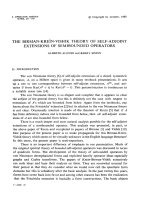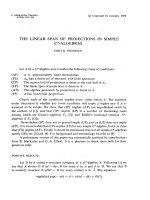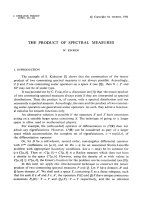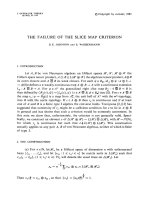Báo cáo toán học: " The Number of [Old-Time] Basketball Games with Final Score n:n where the Home Team was never losing but also never ahead by more than w Point" pot
Bạn đang xem bản rút gọn của tài liệu. Xem và tải ngay bản đầy đủ của tài liệu tại đây (103.12 KB, 8 trang )
The Number of [Old-Time] Basketball Games with
Final Score n:n where the Home Team was never
losing but also never ahead by more than w Points
Arvind Ayyer
Department of Physics
136 Frelinghuysen Rd
Piscataway, NJ 08854.
Doron Zeilberger
Department of Mathematics
110 Frelinghuysen Rd
Piscataway, NJ 08854.
Submitted: Oct 24, 2006; Accepted: Dec 15, 2006; Published: Jan 29, 2007
Mathematics Subject Classification: 05A15
Abstract
We show that the generating function (in n) for the number of walks on the
square lattice with steps (1, 1), (1, −1), (2, 2) and (2, −2) from (0, 0) to (2n, 0) in the
region 0 ≤ y ≤ w satisfies a very special fifth order nonlinear recurrence relation
in w that implies both its numerator and denominator satisfy a linear recurrence
relation.
1 Introduction
We consider walks in the two-dimensional square lattice with steps (1,1), (1,-1), (2,2) and
(2,-2). We assign a weight
√
z for a unit distance along the x-axis. We constrain them to
lie in the region defined by y ≥ 0 and y ≤ w. The motivation for considering such walks
is the modelling of polymers forced to lie between plates separated by a small distance.
One would then like to calculate various combinatorial quantities. In principle, one
hopes to count all possible configurations of the polymer modelling it as a self-avoiding
the electronic journal of combinatorics 14 (2007), #R19 1
walk [WSCM, MTW]. Since this is a tough nut to crack, one simplifying approach is to
treat the polymer as a directed walk.
Studies of this kind have been done in the literature with simpler steps such as Dyck
paths ((1, 1) and (1, −1)) which we review in the next section. See, for example, [DR,
BORW]. For further developments on the subject, see [R] and the references therein.
Even though the motivation came from Physics [BORW], it later occured to us that
this is the number of basketball games (post-1896 and pre-1961, when the three-pointer
did not exist) in which the home team always leads the visitor by at most w points ending
in a tie!
2
´
Etude - Soccer Games
As a warm-up to the study of basketball games, let us consider soccer games with the
same condition [BORW]. These are exactly Dyck walks on the square lattice restricted to
0 ≤ y ≤ w starting at the origin and ending on the x-axis. As is usual, we assign a weight
√
z for both steps.
Let C
w
(z) be the generating function for such a walk. And D
w
(z) be the generating
function for an irreducible walk. That is, one which does not touch the x-axis in the
interior of the walk. A general walk is either the null walk or is composed of an irreducible
walk followed by a smaller such walk. Thus,
C
w
= 1 + D
w
C
w
. (1)
And an irreducible walk starts with the (1, 1) step and ends with the (1, −1) step with
an arbitrary walk in between whose width is w − 1.
D
w
=
√
zC
w−1
√
z
= zC
w−1
, (2)
which implies
C
w
=
1
1 − zC
w−1
. (3)
This leads to a nice continued fraction expression for C
w
, which has the distinct aroma
of Tchebyshev! Notice that C
0
= 1 and thus, C
1
= 1/(1 − z). Then
C
w
=
1
1−
z
1−
···
z
1−
w−2 terms
z
1 − z
for w ≥ 2 (4)
(3) is a patently nonlinear recurrence for the generating function. But it does lead
to a linear recurrence for the numerator and denominator of C
w
. This can be seen by
setting C
w
=
P
w
Q
w
. It is easily seen (do it!) that the linear recurrence relations
P
w
= Q
w−1
(5)
Q
w
= Q
w−1
− zQ
w−2
(6)
the electronic journal of combinatorics 14 (2007), #R19 2
with suitable initial conditions gives rise to C
w
. Notice that these are recurrences with
constant coefficients in w but, of course, not in z. This explains the relationship of the
denominators with Tchebyshev polynomials of the first kind - T
n
(z) which satisfies a very
similar second order recurrence relation in n with constant coefficients, viz.
T
n
(z) = 2zT
n−1
(z) − T
n−2
(z). (7)
As an aside, note that if w = 2, the number of walks ending at (n, 0) give rise to the
Fibonacci numbers and if w = ∞, the Catalan numbers [St].
3 The Main Result - Basketball Games
Definition 1 An [ij] walk is a walk that starts at the line y = i and ends at the line
y = j.
Definition 2 An irreducible [ij] walk is an [ij] walk that touches the minimum of i and
j only at the corresponding endpoint.
We will need various kinds of generating functions in the proof. Let f
[ij]
w
(z) denote the
generating function of the [ij] walk with width w. And let g
[ij]
w
(z) denote the generating
function for the corresponding irreducible version of the walk. Note that, at the end of
the day, we need a recurrence relation for F
w
:= f
[00]
w
.
Theorem 1 Let F
w
be defined as above. Then it satisfies the following recurrence rela-
tion.
F
w
= 1 − zF
w
+ 2zF
w
F
w−1
+ 2z
2
F
w
F
w−1
F
w−2
−(z
3
+ z
4
)F
w
F
w−1
F
w−2
F
w−3
+ z
5
F
w
F
w−1
F
w−2
F
w−3
F
w−4
(8)
To prove this, we first write down a set of equations relating different generating
functions and then try to solve for F
w
. First off, a [00] walk is either the empty walk or
it is composed of an irreducible [00] walk followed by a smaller [00] walk.
f
[00]
w
= 1 + f
[00]
w
g
[00]
w
(9)
Next, a [01] walk is always uniquely composed of an arbitrary [00] walk followed by
an irreducible [01] walk. Similarly, a [10] walk is uniquely composed of an irreducible [10]
walk followed by an arbitrary [00] walk.
f
[10]
w
= g
[10]
w
f
[00]
w
(10)
f
[01]
w
= g
[01]
w
f
[00]
w
(11)
A [11] walk either never goes below the first level, in which case it is simply the same
as a [00] walk with width w − 1, or if it does, it is composed of an irreducible [10] walk
followed by an arbitrary [01] walk.
f
[11]
w
= f
[00]
w−1
+ g
[10]
w
f
[01]
w
(12)
the electronic journal of combinatorics 14 (2007), #R19 3
Now, we go on to describe the irreducible walks. Since we have a finite width, we will
describe them in terms of generating functions for lower widths. In each case, we have
to consider different cases for the starting step and the ending step. First, an irreducible
[00] walk can begin with either the (1, 1) or (2, 2) step and end with either the (1, −1) or
(2, −2) step. If the walk starts with (1, 1) and ends with (1, −1), then there could be an
arbitrary [00] walk with width w − 1 in between. If the walk starts with (1, 1) and ends
with (2, −2), there has to be an arbitrary [01] walk with width w − 1 in between. If the
walk starts with (2, 2) and ends with (1, −1), there has to be an arbitrary [10] walk with
width w −1 in between. And finally, if the walk starts with (2, 2) and ends with (2, −2),
there is a [11] walk with width w − 1 in between.
g
[00]
w
= zf
[00]
w−1
+ z
3/2
f
[01]
w−1
+ z
3/2
f
[10]
w−1
+ z
2
f
[11]
w−1
(13)
For an irreducible [01] walk, we just need to consider the starting steps. If it starts
with (1, 1), the remainder is an arbitrary [00] walk with width w − 1. If it starts with
(2, 2), the remainder is again an arbitrary [10] walk with width w − 1. A very similar
argument on the ending step yields the equation for an irreducible [10] walk.
g
[01]
w
= z
1/2
f
[00]
w−1
+ zf
[10]
w−1
(14)
g
[10]
w
= z
1/2
f
[00]
w−1
+ zf
[01]
w−1
(15)
First we eliminate the irreducible generating functions using equations (13), (14) and
(15). Then equations (9), (10), (11) and (12) become
f
[00]
w
= 1 + f
[00]
w
(zf
[00]
w−1
+ z
3/2
f
[01]
w−1
+ z
3/2
f
[10]
w−1
+ z
2
f
[11]
w−1
) (16)
f
[01]
w
= f
[00]
w
(z
1/2
f
[00]
w−1
+ zf
[01]
w−1
) (17)
f
[10]
w
= f
[00]
w
(z
1/2
f
[00]
w−1
+ zf
[10]
w−1
) (18)
f
[11]
w
= f
[00]
w−1
+ f
[01]
w
(z
1/2
f
[00]
w−1
+ zf
[01]
w−1
). (19)
We clean up our notation now. Let F
w
:= f
[00]
w
, G
w
:= f
[01]
w
, H
w
:= f
[10]
w
, J
w
:= f
[11]
w
.
Then
F
w
= 1 + F
w
(zF
w−1
+ z
3/2
G
w−1
+ z
3/2
H
w−1
+ z
2
J
w−1
) (20)
G
w
= F
w
(z
1/2
F
w−1
+ zH
w−1
) (21)
H
w
= F
w
(z
1/2
F
w−1
+ zG
w−1
) (22)
J
w
= F
w−1
+ G
w
(z
1/2
F
w−1
+ zG
w−1
). (23)
Using (21) and (22),
G
w
− H
w
= zF
w
(H
w−1
− G
w−1
). (24)
But notice that G
0
= H
0
= 0 by definition. Therefore, inductively, G
w
= H
w
. Thus,
G
w
= F
w
(z
1/2
F
w−1
+ zG
w−1
). (25)
the electronic journal of combinatorics 14 (2007), #R19 4
Now we eliminate everything in (20) in the form of G
w
and F
w
using (23) and the
result of (24).
F
w
= 1 + F
w
(zF
w−1
+ z
2
F
w−2
+z
2
G
w−1
(z
1/2
F
w−2
+ zG
w−2
) + 2z
3/2
G
w−1
). (26)
Substituting (25) in (26),
F
w
F
w−1
= F
w−1
+ zF
w
F
2
w−1
+ z
2
F
w
F
w−1
F
w−2
+ z
2
F
w
G
2
w−1
+2z
3/2
F
w
F
w−1
G
w−1
= F
w−1
+ z
2
F
w
F
w−1
F
w−2
+ zF
w
F
w−1
(F
w−1
+ z
1/2
G
w−1
)
+z
3/2
F
w
G
w−1
(F
w−1
+ z
1/2
G
w−1
)
= F
w−1
+ z
2
F
w
F
w−1
F
w−2
+ z
1/2
G
w
F
w−1
+ zG
w
G
w−1
. (27)
Both (26) and (27) have a term of the form G
w
(z
1/2
F
w−1
+ zG
w−1
). From (26),
z
2
F
w
G
w−1
(z
1/2
F
w−2
+ zG
w−2
) = F
w
− 1 − zF
w
F
w−1
− z
2
F
w
F
w−2
− 2z
3/2
F
w
G
w−1
(28)
and from (27),
z
2
F
w
G
w−1
(z
1/2
F
w−2
+ zG
w−2
) = z
2
F
w
(F
w−1
F
w−2
− F
w−2
− z
2
F
w−1
F
w−2
F
w−3
). (29)
Equating the two,
F
w
= 1 + zF
w
F
w−1
+ 2z
3/2
F
w
G
w−1
+ z
2
F
w
F
w−1
F
w−2
− z
4
F
w
F
w−1
F
w−2
F
w−3
. (30)
Substituting the term zF
w
G
w−1
using (25), we get an expression for G
w
in terms of
F
w
’s only.
2z
1/2
G
w
= F
w
− 1 + zF
w
F
w−1
− z
2
F
w
F
w−1
F
w−2
+ z
4
F
w
F
w−1
F
w−2
F
w−3
(31)
Finally, substituting (31) in (30) gives the desired result (8)
Theorem 2 Let X
w
be the generating function for the walk with steps
(1, 1), (1, −1), (p, 2), (p, −2) with p > 0. Then X
w
satisfies a similar recurrence relation
X
w
= 1 − z
p/2
X
w
+ (z + z
p/2
)X
w
X
w−1
+ (z
1+p/2
+ z
p
)X
w
X
w−1
X
w−2
−(z
3p/2
+ z
2p
)X
w
X
w−1
X
w−2
X
w−3
+ z
5p/2
X
w
X
w−1
X
w−2
X
w−3
X
w−4
(32)
The proof follows exactly the same set of ideas. To start off, we define the same set of
generating functions. Equations (9-12) remain the same and equations (13-15) are slightly
modified. Following the steps of the previous proof yields the result
the electronic journal of combinatorics 14 (2007), #R19 5
4 Numerators and Denominators of F
w
Using (8), we will now derive a linear recurrence relation for the numerators and denom-
inators of F
w
.
Theorem 3 Let P
w
and AZ
w
be defined as follows.
P
0
= 1, AZ
0
= 1
P
1
= 1, AZ
1
= 1 − z
P
2
= 1 − z, AZ
2
= 1 − 2z − 3z
2
P
3
= 1 − 2z − 3z
2
, AZ
3
= 1 − 3z − 5z
2
− 2z
3
+ 2z
4
P
4
= 1 − 3z − 5z
2
− 2z
3
+ 2z
4
, AZ
4
= 1 − 4z − 6z
2
+ 2z
3
For w ≥ 5, they are defined recursively by
P
w
= AZ
w−1
(33)
AZ
w
= (1 + z)AZ
w−1
− 2zAZ
w−2
− 2z
2
AZ
w−3
+ (z
3
+ z
4
)AZ
w−4
− z
5
AZ
w−5
(34)
Then, F
w
:=
P
w
AZ
w
is precisely the generating function for the walk defined earlier satis-
fying the recurrence relation (8).
These denominators are to basketball what Tchebyshev polynomials are to soccer.
For w ≤ 4, the generating functions are given by
F
0
= 1 (35)
F
1
=
1
1 − z
(36)
F
2
=
1 − z
1 − 2z − 3z
2
(37)
F
3
=
1 − 2z − 3z
2
1 − 3z − 5z
2
− 2z
3
+ 2z
4
(38)
F
4
=
1 − 3z − 5z
2
− 2z
3
+ 2z
4
1 − 4z − 6z
2
+ 2z
3
(39)
and therefore, the initial conditions give the right generating function. To see that (33,34)
imply (8), divide (34) by AZ
w
. Then,
1 = (1 + z)
AZ
w−1
AZ
w
− 2z
AZ
w−2
AZ
w
− 2z
2
AZ
w−3
AZ
w
+ (z
3
+ z
4
)
AZ
w−4
AZ
w
− z
5
AZ
w−5
AZ
w
. (40)
the electronic journal of combinatorics 14 (2007), #R19 6
But now, using (33)
AZ
w−1
AZ
w
= F
w
, (41)
AZ
w−2
AZ
w
= F
w−1
F
w
, (42)
AZ
w−3
AZ
w
= F
w−2
F
w−1
F
w
, (43)
AZ
w−4
AZ
w
= F
w−3
F
w−2
F
w−1
F
w
, (44)
AZ
w−5
AZ
w
= F
w−4
F
w−3
F
w−2
F
w−1
F
w
. (45)
which implies (8)
5 Remarks
For the sake of completeness, we give references to the number of such basketball games
for various values of w. For w = 2, ··· , 6 and w = ∞, the sequence of games ending at
n : n is in [Sl]. Except for the case of w = 2, which also arises in some other contexts, all
other sequences are new.
Let us now point out why this recurrence is so special! First of all, notice that all
terms in (8) involve only successive generating functions. It is precisely this property that
leads to a linear recurrence relation for the denominators. Let us look at this in a little
more detail.
Consider the generating functions F
w
, G
w
, H
w
, J
w
defined earlier by equations (20-23).
It will not be shown, but it does turn out that the denominators for all four of them are
preceisely AZ
w
. Denote their numerators by P
w
, g
w
, h
w
, j
w
respectively. Rewriting (20-23)
gives
P
w
AZ
w
= 1 +
P
w
AZ
w
AZ
w−1
(zP
w−1
+ z
3/2
g
w−1
+ z
3/2
h
w−1
+ z
2
j
w−1
) (46)
g
w
AZ
w
=
P
w
AZ
w
AZ
w−1
(z
1/2
P
w−1
+ zh
w−1
) (47)
h
w
AZ
w
=
P
w
AZ
w
AZ
w−1
(z
1/2
P
w−1
+ zg
w−1
) (48)
j
w
AZ
w
=
P
w−1
AZ
w−1
+
g
w
AZ
w
AZ
w−1
(z
1/2
P
w−1
+ zg
w−1
) (49)
But notice that P
w
= AZ
w−1
and therefore, the first three of these equations are linear
but the fourth is not! In fact, if the fourth were also linear, there is no way the recurrence
for P
w
would terminate uniformly in w. The nonlinearity of the fourth equation almost
miraculously cancels out excess terms that arise in the fifth order recurrence.
the electronic journal of combinatorics 14 (2007), #R19 7
REFERENCES
[BORW] R. Brak, A.L. Owczarek, A. Rechnitzer, S.G. Whittington, A directed walk
model of a long chain polymer in a slit with attractive walls, J. Phys. A, 38, 2005, 4309-
4325.
[DR] E.A. DiMarzio and R.J. Rubin, Adsorption of a Chain Polymer between Two
Plates, J. Chem. Phys., 55, 1971, 4318-36.
[MTW] Keith M. Middlemiss, Glenn M. Torrie and Stuart G. Whittington, Excluded
volume effects in the stabilization of colloids by polymers, J. Chem. Phys., 66, 1977,
3227-32.
[R] E.J. Janse van Rensburg, The statistical mechanics of interacting walks, polygons,
animals and vesicles, Oxford Lecture Series in Mathematics and its Applications, 18.
Oxford University Press, Oxford, 2000.
[Sl] N.J.A. Sloane, Sequences A046717,A127617-620,A122951 in the OEIS,
/>[St] Richard Stanley, Chapter 6 of Enumerative Combinatorics V.2, Cambridge Studies
in Advanced Mathematics, 62. Cambridge University Press, Cambridge, 1999.
[WSCM] Frederick T. Wall, William A. Seitz, John C. Chin and Frederic Mandel,
Self-avoiding walks subject to boundary constraints, J. Chem. Phys., 67, 1977, 434-38.
the electronic journal of combinatorics 14 (2007), #R19 8









